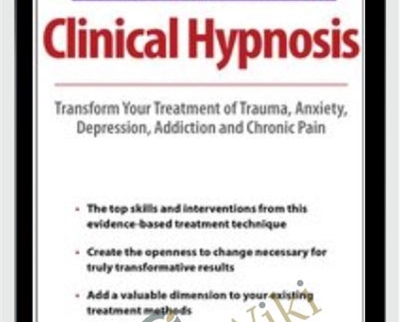$439.99 Original price was: $439.99.$171.00Current price is: $171.00.
But sometimes a lack of focus in therapy brings progress to a screeching halt. And traditional treatment approaches can fail to create the openness to change needed to make the therapeutic experience a life-altering one.
 Purchase this course you will earn 171 Points worth of $17.10
Purchase this course you will earn 171 Points worth of $17.10Elevate your skills with the 2-Day Training on Clinical Hypnosis: Transform Your Treatment of Trauma, Anxiety, Depression, Addiction and Chronic Pain – Eric K. Willmarth course, available for just $439.99 Original price was: $439.99.$171.00Current price is: $171.00. on Utralist.com! Browse our curated selection of over 60,000 downloadable digital courses across diverse Uncategorized. Benefit from expert-led, self-paced instruction and save over 80%. Start learning smarter today!
Providing hope and healing is the kind of work that makes you come alive. And you strive to help each client who’s counting on you to deliver.
But sometimes a lack of focus in therapy brings progress to a screeching halt. And traditional treatment approaches can fail to create the openness to change needed to make the therapeutic experience a life-altering one.
Watch this intensive course recording and get indispensable skills and tools from clinical hypnosis to create the focused, relaxed and attentive context necessary to bring about truly transformative results with your clients!!!
Dr. Eric Willmarth is a past president of the American Society for Clinical Hypnosis, the Society for Psychological Hypnosis (APA Div. 30), and the Society for Clinical and Experimental Hypnosis.
Watch him as he shares the skills and techniques he’s found most effective during his decades of clinical work.
He’ll teach you the core skills of hypnosis and provide you with step-by-step instructions and demonstrations on hypnotic techniques that will amplify the effectiveness of the therapeutic modalities you already work with.
Add valuable dimensions to your treatment toolbox, and feel more capable and confident in helping your clients conquer their anxiety, depression, pains, addictive behaviors and traumatic pasts!
- Assess the clinical relevance of the relationship between hypnosis and memory.
- Specify how clinicians can identify situations in which hypnosis could be beneficial.
- Establish how hypnotic language can be utilized with various treatment modalities.
- Communicate 3 techniques that can be used to elicit a constructive trance experience in therapy.
- Present a synopsis of the three-stage skeleton of an hypnotic induction sequence.
- Provide the names of 3 different hypnotic phenomena that can be utilized to enhance therapy.
- Characterize how the hypnotic phenomena present in a client can help the clinician individualize treatment.
- Establish how verbal indirect suggestions can be employed in session to move clients toward positive changes in behavior.
- Articulate how non-verbal communication skills from clinical hypnosis can be used to help calm hyper-aroused clients.
- Establish how metaphor and anecdotes can be used in a hypnosis session to help facilitate new patterns of thoughts, feelings and behaviors in clients.
- Communicate how confusion techniques can be used to capture the attention of clients in sessions.
- Connect specific hypnotic techniques to the clinical treatment of trauma, anxiety, depression and pain.
Discover the Core Skills of Hypnosis
- Brief history of clinical/medical hypnosis
- Ethics of clinical hypnosis
- When should hypnosis be used in therapy?
- Hypnotic change language for clinicians
- Intrapersonal and interpersonal dynamics
- How to disrupt patterns to encourage flexibility
- Hypnosis as an adjunctive technique
- The neurophysiology of Hypnosis
Methods to Elicit a Trance Experience: Increase Focus and Relaxation to Intensify Therapy
- Assess for willingness and hypnotic ability
- Hypnotic phenomena
- Three-stage “skeleton” of an induction sequence
- Relaxation techniques
- Visualization to recall positive memories
- Countdown breathing
How to Structure a Hypnosis Session
- How to use hypnosis across modalities
- Relaxation
- Rapport
- Induction
- Deepening
- Waking
- Hypnotic techniques to work with resistances
- Apply hypnosis methods without a formal trance
Hypnosis Skills and Techniques for Specific Disorders and Conditions
Trauma: Restore Control and Process Traumatic Memories
- How hypnosis works with exposure
- Hypnosis techniques to restore control to clients
- Regression for processing traumatic memories
- Practices to alter distorted beliefs
- Hypnotic suggestions to foster greater emotional control
Anxiety: Shift Clients to Calm with Hypnotic Suggestion
- Strategies to get to the root of your client’s anxiety
- Hypnosis and metaphor to redefine anxiety
- Exercises to manage the energy of anxiety
- Hypnotic techniques to improve sleep in anxious clients
Depression: Breaking the Cycles of Depression
- Combining hypnosis and CBT for mood control
- Using hypnotic age regression and progression for depression
- Mesmer, music, mood and movement
- Using creative stories to reconceptualize depression
Acute and Chronic Pain: Interventions to Change Clients’ Minds and Pain
- Altering the perception of pain
- Hypnotic interventions to dissociate clients from the reality of pain
- Shift clients’ attention from painful sensations
- Forgetting about the pain with amnesia
- Expand time and expand comfort
- Elicit vivid memories to obviate pain
Addiction: Release Clients from Addictive Behavior Patterns
- How to use hypnosis to create a different perspective
- Hypnotic suggestions to strengthen willpower
- Self-hypnosis to overcome addictive urges and cravings
- Ease withdrawal symptoms with hypnosis
Experiential Workshop: Elicit a Trance State for Enhanced Responsiveness in Therapy
Get 2-Day Training on Clinical Hypnosis: Transform Your Treatment of Trauma, Anxiety, Depression, Addiction and Chronic Pain – Eric K. Willmarth, Only Price $175
Tag: 2-Day Training on Clinical Hypnosis: Transform Your Treatment of Trauma, Anxiety, Depression, Addiction and Chronic Pain – Eric K. Willmarth Review. 2-Day Training on Clinical Hypnosis: Transform Your Treatment of Trauma, Anxiety, Depression, Addiction and Chronic Pain – Eric K. Willmarth download. 2-Day Training on Clinical Hypnosis: Transform Your Treatment of Trauma, Anxiety, Depression, Addiction and Chronic Pain – Eric K. Willmarth discount.
Cultivate continuous growth with the 2-Day Training on Clinical Hypnosis: Transform Your Treatment of Trauma, Anxiety, Depression, Addiction and Chronic Pain – Eric K. Willmarth course at Utralist.com! Unlock lifetime access to premium digital content, meticulously designed for both career advancement and personal enrichment.
- Lifetime Access: Enjoy limitless access to your purchased courses.
- Exceptional Value: Benefit from savings up to 80% on high-quality courses.
- Secure Transactions: Your payments are always safe and protected.
- Practical Application: Gain real-world skills applicable to your goals.
- Instant Accessibility: Begin your learning journey immediately after buying.
- Device Compatible: Access your courses seamlessly on any device.
Transform your potential with Utralist.com!
Related products
Uncategorized
= 35 Points
Uncategorized
= 35 Points
= 72 Points
= 85 Points
Uncategorized
= 30 Points
= 84 Points
Uncategorized
Proven Fall Prevention Strategies: Exercise, Meds Management and Home Modification – Trent Brown
= 40 Points
Uncategorized
= 85 Points





